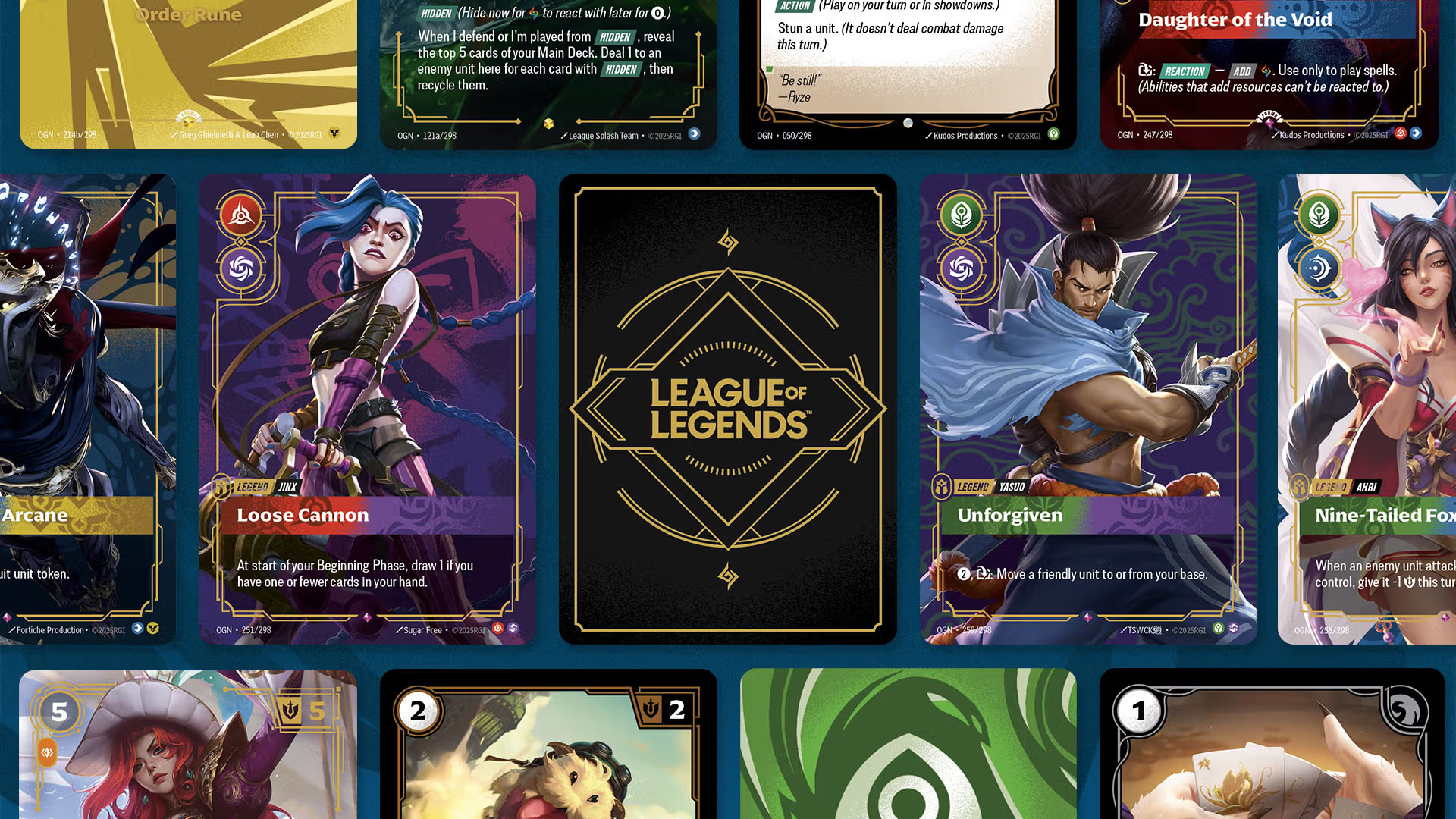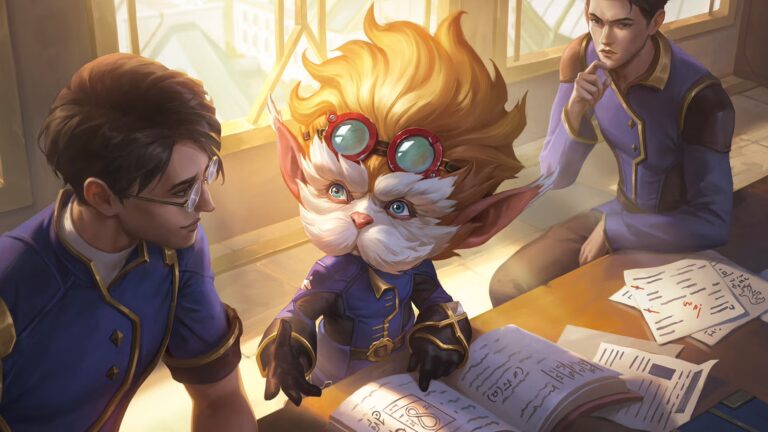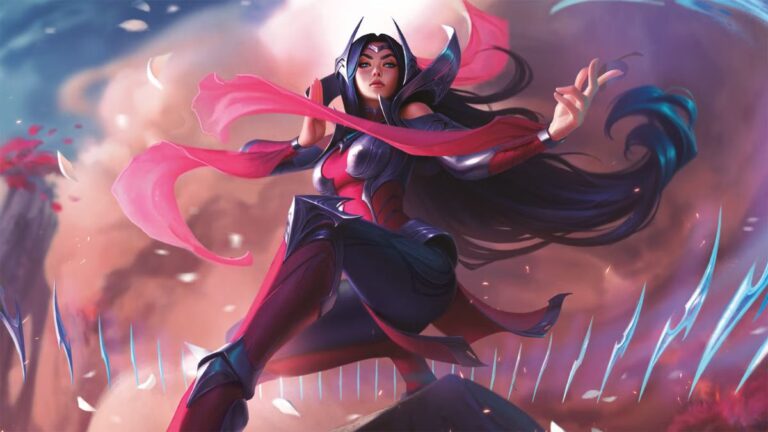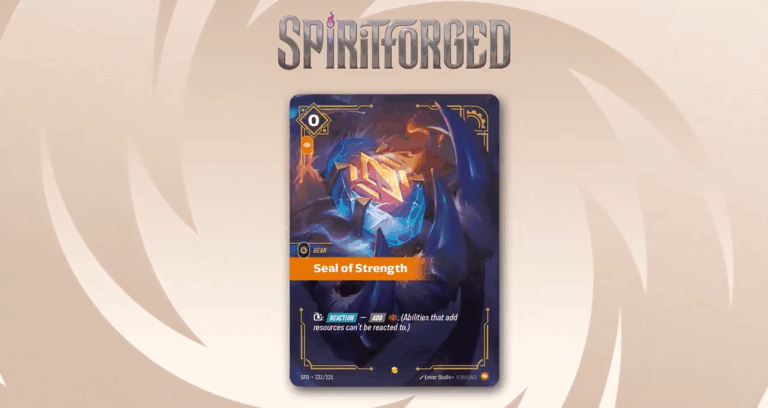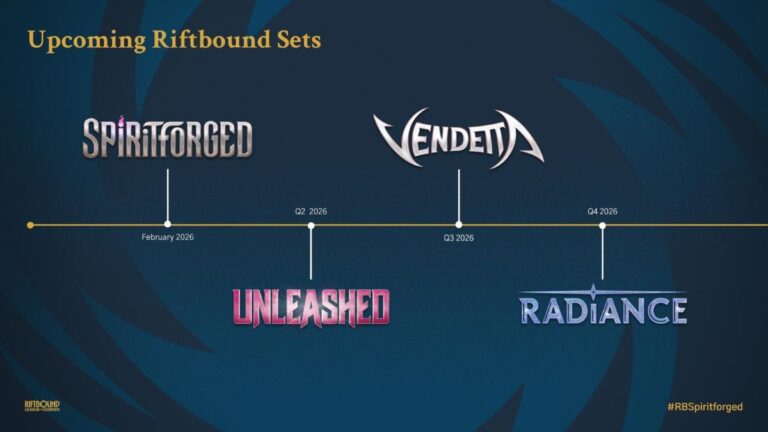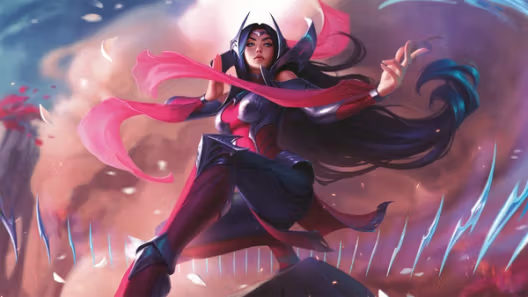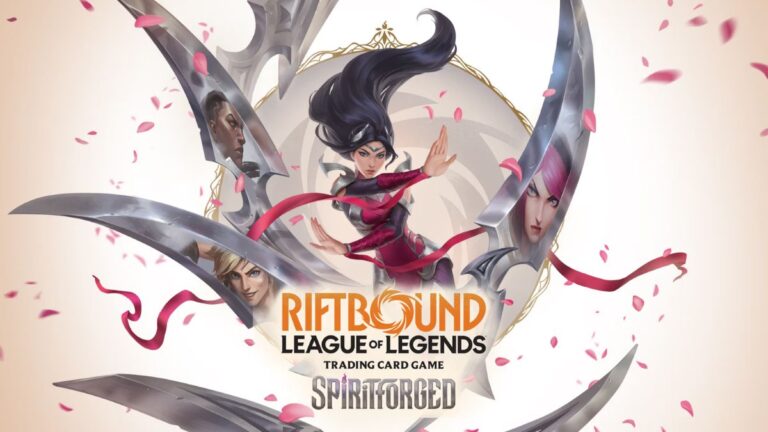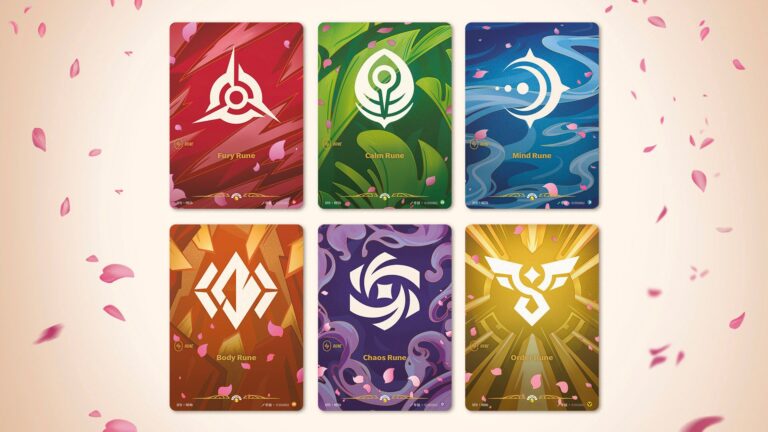Contents
Across the last few months, we’ve seen Riftbound develop from its first few legends into an official card game; from early online and proxy tournaments all around the globe to the first official tournaments in China, Riot’s League of Legends trading card game has captured the hearts of both its existing fans and TCG fans worldwide.
Leading up to the Western release of their first set Origins at the end of October, you may be interested in joining in on the fun; but if you’re unsure how the game works, or have never played a trading card game before, it can be overwhelming to know where to start with building your very first deck.
In this guide, we’ll be breaking down the steps to making your own Riftbound deck, everything you need to consider, any tips and tricks to make the whole process easier, and any official rules you’ll need to know to ensure your deck is in perfect shape for your first game of Riftbound.
Choosing Your Legend
Within Riftbound, the basics of every constructed deck lies in the Champion Legend. Your Champion Legend can define a lot of things about your deck: Each Legend has a unique ability that may shape the deck’s gameplay, and has two Domains that they can access, which can be seen by the Rune symbols & colors on the card. Unlike other TCG’s like Magic the Gathering, where you can construct a deck using as many (or as little) domains as you’d like, in Riftbound you are limited to the two domains that your Champion Legend can use. So, how do I know which deck to build?
One way to find out is to research into what each of Riftbound’s domains mean. Each of the Six domains; Fury, Calm, Mind, Body, Chaos and Order; all have specific meanings, designs, and gameplay choices that allows for each card pool to be unique, and when paired together can create some truly exciting strategies.
Check out our article Domain 101 to find out more about each individual domain, their best gameplay strategies, and how to choose the right ones for you!
The other way to find what deck suits you is to take a look at all the Champion Legends currently on offer, and their card’s ability. This can usually signify what their deck’s strengths are, and give you a face-value understanding of their gameplan. For example, the legend Teemo Swift Scout might want to play in the midrange, setting the tempo by hiding cards to play later as a reaction and bamboozle the opponent, while always making sure they have a Teemo unit ready to use, whereas the legend Jinx Loose Cannon might want to play or discard their cards as quickly as possible to trigger the extra card draw, signalling this is likely a fast-paced aggressive gameplan.
Some Champion Legends can have the same domain-pools as each other, but still have a different gameplay strategy in mind. For example, while both Master Yi Wuju Bladesman and Lee Sin Blind Monk want to buff a friendly unit, Master Yi has an emphasis on buffing lone-defending units, signifying a more midrange/defensive approach to his decklist, whereas Lee Sin can give a smaller buff to any friendly unit, leaving him open to taking the aggressive approach if need be.
Although there are not too many legends within the game right now, there will certainly be more as the game grows and expands, so if there isn’t an exact legend that suits you at this moment, don’t fret; your perfect match may be in a booster box near you sometime in the future.
Building Your Deck
Once you’ve chosen your Champion Legend, it’s time to build the rest of your deck. In Riftbound, there are four areas of deckbuilding you have to consider:
- Main Deck, consisting of 40 cards, including your Chosen Champion;
- Rune Pool, where all your resources are located, consisting of 12 cards;
- Battlefields, the capture zones that make up every match of Riftbound, consisting of 3 unique cards;
- And the Sideboard, which must be exactly 8 or 0 cards.
To plan out your decklist, use our deckbuilder right here on Riftbound.gg! You’ll be able to select everything you need for your decklist, and access every single card instantly, letting you build your ideal decklist with no limitations!
Chosen Champion
Overall, we recommend beginning to build the Main Deck first, as once you have a solid idea of what your gameplan is, the other three sections should fall into place quite nicely. First and foremost, we recommend selecting your Chosen Champion. Each Legend will have two Champion cards to accompany them, one in each of their domain types. Having a Chosen Champion is important, as this card will not start in your main deck, rather on the board to be played at any point during the game; ensuring your Champion lines up with your preferred gameplan is important.
For example, the two Teemo legends are Teemo Strategist and Teemo Scout. Strategist would require your deck to be filled with cards that use Hidden (or any cards with a reveal mechanic) to get the most value out of its ability, whereas Scout has a much simpler ability that could fit into virtually any Teemo decklist. In your main deck, you could decide to run 3 of each of the matching Champion units, or up to 3 of any Champion unit in your domains, but for your Chosen Champion, you must choose one only out of the two that match your Legend.
Alongside this, every Legend has a unique Signature Ability card. It is not required for you to run these in your decklist, but they are definitely worth checking out when building your own decklist, as a lot of them are more powerful than your average card, and could work extremely well for the gameplan you have in mind.
Main Deck
The next step is building the bulk of your decklist. Although you may have an idea in mind of what direction you’d like to take, it can be overwhelming to decide what exactly to include in your decklist. Here are a few tips to help you get started:
- Don’t focus too much on the endgame: In Riftbound, your main goal is to claim and hold battlefields, which can be hard to do if your deck is filled with high-cost endgame closers. Make room for 9-12 low-cost units, and a few more low-cost spells too, to ensure you can draw them easily enough in the early game.
- Spells can Save you: Often within Riftbound games, many showdowns will come down to the last hair; a single spell can shake up the entire match. Many spells in Riftbound are reactive; whether you’re buffing your own units or dealing 3 to an enemy unit, having these spells in your deck will improve both your deck’s efficiency and your own enjoyment in the game. Aim for 6-9 low-medium cost spells, with some larger powerful spells as the cherry on-top.
- Don’t overdo it: It can be easy to get carried away with choosing different spells and gear for your decklist. Overall, it's best to run more Units than spells, especially ensuring you have a range of smaller, medium, and larger Champion units to successfully hold the battlefields with.
Rune Pool
For your Rune Pool, you’ll need to decide how many of each Rune you’ll want to run in your deck. The easiest way to start with this is by running 6 of each Rune, and if you’re having any trouble with resources, adjusting to a 5/7 or 4/8 split where necessary.
Battlefields
When choosing your battlefields, there are two angles which you can approach this from: Deciding which overall work best with your decklist, or which is best to play in your first and second matches, and which is best for the tiebreaker game.
Our Battlefields 101 guide can help you gain a deeper understanding of how battlefields work, and ensure you know everything you need to enter your first game of Riftbound confidently!
Sideboard
Finally, when deciding your sideboard, you should aim to add in any cards for specific matchups, whether it’s reactive spells or extra backup in the tougher games. If you’re playing competitively, you may want to consider cards to help into tougher matchups for your Legend, or when going into the S-tier legends at the top of the metagame. If you’re just playing casually, you can tailor your sideboard however you choose; whether it’s extra support spells, or gear-hate for that pesky Darius Hook player, your sideboard is best when it’s tailored to your plan.
One quick thing to note is that you can’t exceed the legal limit of cards between your deck and your sideboard. If you’re running three copies of Pouty Poro in your main deck, you’re not allowed to add another one into your sideboard. However, two in your main deck and one in your sideboard is perfectly fine. You can also choose not to have a sideboard at all, which is useful if you’re mainly playing best-of-one matches, as you’re not allowed to sideboard in these.
Closing Time
And there you have it, your first Riftbound deck! Whether you’re playing online, casually with friends, or turning up to your first local Nexus Nights, we hope this guide has prepped you well. Whether you smash all your games or your decklist needs a little altering, the most important thing of all is to have fun in Riftbound!
At the moment of publication, Origins has not yet been released in the West, and we’re still in the very early days of the game, so there could be some rules changes and clarifications to come. We’ll be updating this article as any information changes, so you can be sure you’re up to date with any major changes.
If you’re looking for more Riftbound content to get stuck into, check out Riftbound.gg! We’ll be bringing you the latest news, from Deck Guides to Tournament Reports, ensuring you have all the knowledge you need before Origins’ Western release on October 31st.
In any case, thank you for your time, and I’ll see you on the rift.

